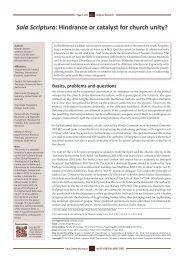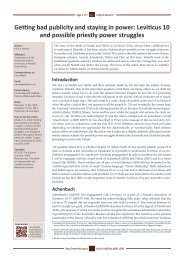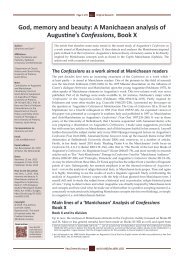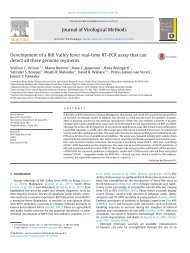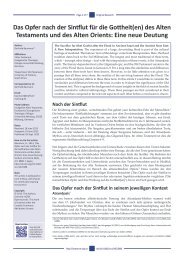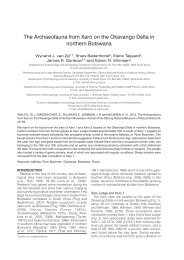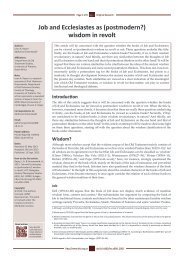Revised nomenclature and classification of inherited ichthyoses ...
Revised nomenclature and classification of inherited ichthyoses ...
Revised nomenclature and classification of inherited ichthyoses ...
You also want an ePaper? Increase the reach of your titles
YUMPU automatically turns print PDFs into web optimized ePapers that Google loves.
JAM ACAD DERMATOL<br />
VOLUME 63, NUMBER 4<br />
as summarized in Table XIII, <strong>and</strong> should be amenable<br />
to modification as new information emerges.<br />
AIMS AND LIMITATIONS OF THE<br />
CONSENSUS REPORT<br />
The overall goal <strong>of</strong> the revised <strong>classification</strong> is to<br />
clarify the terminology <strong>of</strong> this heterogeneous group <strong>of</strong><br />
<strong>inherited</strong> skin diseases (Table I). The <strong>classification</strong><br />
scheme <strong>and</strong> nosology should<br />
be easily underst<strong>and</strong>able for<br />
all clinicians, biologists, <strong>and</strong><br />
students. It should guide clinicians<br />
toward the correct<br />
genotyping <strong>of</strong> their patients<br />
<strong>and</strong> facilitate communication<br />
with investigators. The proposed<br />
<strong>classification</strong> (Tables II<br />
<strong>and</strong> III) will need to be<br />
modified or exp<strong>and</strong>ed as<br />
new information accrues.<br />
A pathophysiologic <strong>classification</strong><br />
<strong>of</strong> the <strong>ichthyoses</strong> <strong>and</strong> all<br />
MEDOC should be initiated in<br />
the future (Table XIII).<br />
RECOMMENDED<br />
REVISION OF THE<br />
TERMINOLOGY AND<br />
CLASSIFICATION OF<br />
INHERITED<br />
ICHTHYOSIS<br />
The generic term ‘‘<strong>inherited</strong><br />
ichthyosis’’ refers to<br />
diseases that are MEDOC af-<br />
CAPSULE SUMMARY<br />
fecting all or most <strong>of</strong> the integument. The skin changes<br />
are clinically characterized by hyperkeratosis, scaling,<br />
or both. Despite concern among some participants that<br />
the term ‘‘ichthyosis’’ 2 is outmoded <strong>and</strong> sometimes<br />
inaccurate, the consensus was to retain it, as it is too<br />
firmly entrenched in the literature <strong>and</strong> minds <strong>of</strong> clinicians<br />
to be ab<strong>and</strong>oned. Inherited <strong>ichthyoses</strong> are<br />
regarded as one disease group within the greater<br />
group <strong>of</strong> MEDOC. For greater clarity, we redefined<br />
some important clinical <strong>and</strong> dermatologic terms that<br />
areincommonusage(Table I). Specifically, the revised<br />
<strong>classification</strong> is based on consent to a specific definition<br />
<strong>of</strong> the term ‘‘autosomal recessive congenital ichthyosis’’<br />
(ARCI), <strong>and</strong> a major change to <strong>nomenclature</strong><br />
<strong>of</strong> the <strong>ichthyoses</strong> caused by keratin mutations (see<br />
below).<br />
General framework for the revised<br />
<strong>classification</strong> system<br />
At present, molecular diagnosis is not available<br />
for all forms <strong>of</strong> ichthyosis, <strong>and</strong> access to genetic<br />
d Inherited <strong>ichthyoses</strong> belong to a large<br />
<strong>and</strong> heterogeneous group <strong>of</strong> mendelian<br />
disorders <strong>of</strong> cornification <strong>and</strong> involve the<br />
entire integument.<br />
d A conference <strong>of</strong> experts was convened<br />
to reach a consensus on terminology<br />
<strong>and</strong> <strong>classification</strong> <strong>and</strong> to provide an<br />
internationally accepted frame <strong>of</strong><br />
reference.<br />
d The <strong>classification</strong> remains clinically based<br />
<strong>and</strong> distinguishes between syndromic<br />
<strong>and</strong> nonsyndromic ichthyosis forms.<br />
d Bullous ichthyosis/epidermolytic<br />
hyperkeratosis is redefined as<br />
keratinopathic ichthyosis. Autosomal<br />
recessive congenital ichthyosis refers to<br />
harlequin ichthyosis, lamellar ichthyosis,<br />
<strong>and</strong> congenital ichthyosiform<br />
erythroderma.<br />
Oji et al 609<br />
diagnostics may be impeded by the high cost <strong>of</strong><br />
analysis. Similarly, ultrastructural techniques are not<br />
in common clinical use by pathologists <strong>and</strong> are not<br />
widely available to clinicians. Other laboratory techniques,<br />
including light microscopy, narrow the differential<br />
diagnoses in some cases (see ‘‘Diagnostic<br />
Aspects’’ section), but decisions regarding further<br />
testing, ie, molecular diagnostics, rest on an initial,<br />
rigorous clinical evaluation.<br />
Therefore, the result <strong>of</strong> the<br />
consensus discussion process<br />
is a clinically based <strong>classification</strong>,<br />
in which the diseases are<br />
referenced with the causative<br />
gene or genes. Two principal<br />
groups are recognized: nonsyndromic<br />
forms (Table II)<br />
<strong>and</strong> syndromic forms (Table<br />
III). This algorithm is in the<br />
tradition <strong>of</strong> previous concepts<br />
3,12-14 <strong>and</strong> based on the<br />
following question:<br />
d Is the phenotypic expression<br />
<strong>of</strong> the disorder only<br />
seen in the skin (prototypes:<br />
lamellar ichthyosis<br />
(LI) <strong>and</strong> epidermolytic ichthyosis<br />
[EI]), or is it seen in<br />
the skin <strong>and</strong> in other organs<br />
(prototypes: Sjögren-Larsson<br />
syndrome <strong>and</strong> trichothiodystrophy<br />
[TTD])?<br />
Noteworthy, recessive<br />
X-linked ichthyosis (RXLI) is regarded as syndromic<br />
when accompanied by associated manifestations<br />
such as testicular maldescent, <strong>and</strong> nonsyndromic<br />
when ichthyosis occurs as an isolated type 3 without<br />
extracutaneous signs. To facilitate the readability <strong>and</strong><br />
underst<strong>and</strong>ing <strong>of</strong> the long list <strong>of</strong> autosomal ichthyosis<br />
syndromes, subheadings have been introduced<br />
that point to the prominent associated signs, eg, hair<br />
abnormalities or neurologic signs (Table III).<br />
Another question distinguishes between congenital<br />
ichthyosis <strong>and</strong> <strong>ichthyoses</strong> <strong>of</strong> delayed onset. This<br />
criterion is important for common <strong>ichthyoses</strong> (Table<br />
IV), namely ichthyosis vulgaris (IV) <strong>and</strong> RXLI, which<br />
<strong>of</strong>ten have a delayed onset (Fig 1). However, early<br />
subtle skin changes may be overlooked, eg, RXLI<br />
may present with fine superficial scaling shortly after<br />
birth, which may fade within weeks <strong>and</strong> recur as a<br />
clear ichthyosis in later life. Therefore, considering<br />
the high variability <strong>of</strong> the initial disease presentation<br />
<strong>of</strong> some <strong>ichthyoses</strong>, eg, TTD, the age <strong>of</strong> onset has not<br />
been chosen as a major <strong>classification</strong> criterion.



